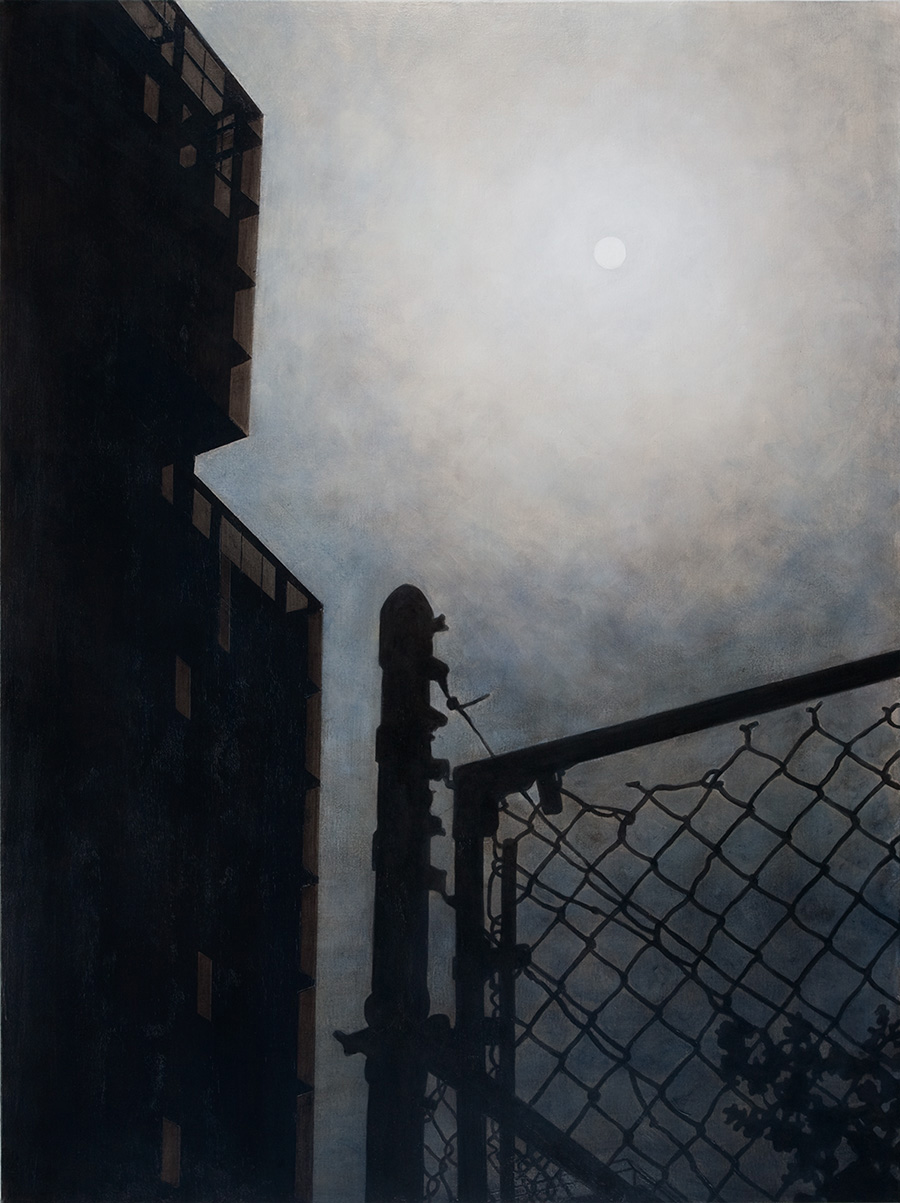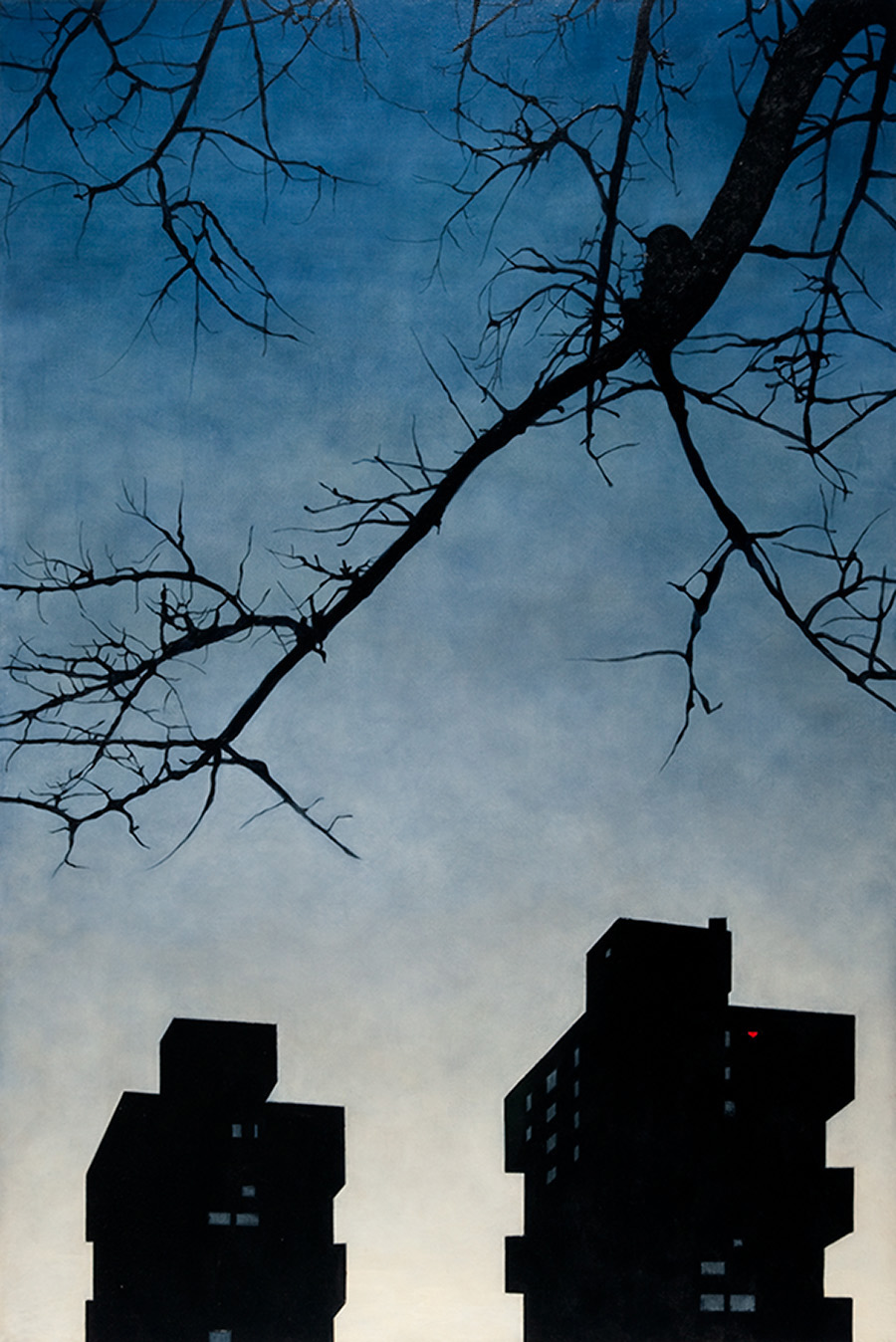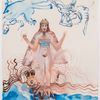"The boy got on his knees at a beam of light, pushed his face to the
ground to try to see where the dividing line lay between sun and shadow. What was it that bisected reality, illuminated one shifting piece of the street while next to it another remained gray." Columns, Benjamin Beckett
Liz Insogna:Please elaborate a bit on the title of the show Eigengrau or "intrinsic gray" as per its meaning and how this meaning relates to the shared ground between your work and the work of Lauren Seiden in your show together at Storefront Bushwick.
Frank Webster: When discussing a title for the show, it occurred to us that both of our work shared an interest in the darker tonal ranges of color. Eigengrau is a medical term for the brain's gray, the color just before pure black that the brain sees with only the light produced by the faint energy of the optic nerve. This seemed to speak to the subtlety of the works in the show. We both liked the term because of its poetic, open ended quality. We also liked the musical sound of the word.
LI: That's really interesting. So is it safe to say that during moments of total darkness we produce a tiny light (through the energy of the optic nerve) and that this is what we associate with the presence of gray in vision?
FW: That's right. You could say our brain and optic nerve produce their own infinitesimal light, the background gray of the brain.
LI: So, if one wakes in the middle of the night in total darkness, it should be gray that we see? If black is the absorption (or absence) of light would gray be its close second? Part of the concept touches upon such interesting phenomena. I think I've always linked the color gray with Jasper Johns and this is not the type of gray I see in your paintings -- which appear as more of an absorbed darkness.
FW: It is an interesting phenomenon. I wonder if there is ever a point short of total blindness when we would experience a real black.
Surprisingly, you are only the second person to mention Jasper Johns. Both of you are artists. I've always liked the way Johns used the color gray to neutralize and abstract his paintings so that he could emphasize the philosophical ideas he was interested in.
LI: Yes, I wonder. Having this conversation, I can't help but think of all of the associations one has with darker tonalities especially with the night, which is an impression emitted from your paintings even when it is not literally so, as in, Tree and Tower Tokyo. Is it true that you don't have any particular attachments to images, things, emotions or ideas with gray or dark shades?
FW: I don't have negative associations with these darker tonalities. I'm not particularly morose or anything like that. The images do often have a personal meaning to me, but I tend to favor more detached means of expression and like to let the viewer have some free range for interpretation. For me, understatement can sometimes be more emotionally powerful than histrionics and sturm und drang. I like the tightly wound and interior approach. Thus my soft spot for minimalism, I guess.

Frank Webster, Tree and Tower, Tokyo,2011, acrylic on canvas, 60" x 45"
Image Courtesy of Bushwick Storefront and Blackston Gallery, photo by Myriam Babin Photography
LI: Also referring to (and directly quoting from) the press release, could you comment on how your "work investigates absence, the numinous and meaning at the edge of perceptual and psychological experience." I'm most curious about a relationship to the spiritual quality as pointed toward in the quote above.
FW: In my work, absence most directly manifests itself in the absence of a human figure for the viewer to construct a narrative about. The figure in my paintings then becomes the viewer herself. This viewer is thrown into a perceptual experience of the mystery of the everyday world. I am interested in moments when time seems to slow down and one begins to appreciate something simple, perhaps even mundane, as numinous and full of unspoken potential. On one level, these paintings are about the psychological experience of quietude -- a moment of abstract reflection in a frenetic urban environment for instance.
LI: I like how open ended the paintings are. The absence of the figure creates a palpable landscape for the viewers' presence -- either on a phenomenological level or through memory. As the painter, do you relate to either of these phenomena with the work or in the research surrounding it?
FW: Yes, both of these ideas (memory and phenomenology) are important to my work. Memory -- especially its unreliability with regards to perception -- is very interesting to me. As far as phenomenology goes, I do believe with Merleau-Ponty that we exist in a compound relationship with the world -- I would go so far as to say there is no inner being without a complex interconnectedness to our environment. I guess this is one of the things that brought me to my rather phenomenological approach to landscape -- a search for something essential in the world of appearances.
LI: I'm curious about the deeper connections with memory and the work. Is distortion (in terms of the unreliability of perception) something that naturally makes its way in? How do you relate to it, if so?
FW: I definitely relate to and use the distortion that happens with the transcription and reproduction of an image. My process involves photography and drawing as preparatory stages for a painting. During this process I look for moments of abstraction and simplification -- the sort of confusion of space that sometimes happens in photography. I think a lot about the fluidity of memory when I make a painting, the unreliability of the eyewitness -- the way that five people can see the same event and each remember something completely different. I recall reading an article on cognitive science once that talked about how our brains run movies of what we remember seeing when looking at a scene. You can subtly change this scene and have it go unnoticed unless the viewer is prompted. These fugitive elements of consciousness play into how I look at painting.

Frank Webster, Fence, 2011, acrylic on canvas, 60" x 45",
Image Courtesy of Bushwick Storefront and Blackston Gallery, photo by Myriam Babin Photography
LI: Tell me more about what you've found that's essential.
FW: I think when I talk about essentials, I mean getting down to basics. What is the simplest most direct way for me to present this image? I am a fan of Japanese Zen painting and admire that sort of no nonsense way of saying more with less. When my painting works, it should have some of that effortless quality to it -- even if it belies a lot of sweat and labor.
LI:In an earlier conversation, you mentioned the romantic aspect of a city as a natural component to its presence. Since you're working directly with New York City and Tokyo in the works for Eigengrau, I thought it fitting to ask you to talk more about this.
FW: Yes, I think we were talking about pre-industrial era romantic artists like Casper David Friedrich and what they might make of our hypermodern urban environment. I'm reminded of one of my favorite films, Alphaville by Jean-Luc Godard (originally titled Tarzan vs. IBM). I remember reading an interview with Godard where the director was asked about shooting Paris exclusively at night for that film. To paraphrase, Godard said that the night represented for him adventure and romance. I think that is a wonderful way to sum up what is beautiful about a city at night. Of course, Godard's Paris is a lot more in that film -- he intentionally shot the then burgeoning international-style high-modernist architecture of the period to give his film a "science fiction" feel. In doing so he managed to see the future in the present -- something I am very aware of when exploring megacities like New York and Tokyo. I am both attracted and repelled by the futurity these places, on that level perhaps I find them sublime in much the same way Friedrich may have found the ruins of a gothic church.

Frank Webster, Black Towers, 2010, acrylic on canvas, 72" x 48", Image Courtesy of Bushwick Storefront and Blackston Gallery, photo by Myriam Babin Photography
Eigengrau is up through May 19th at Storefront Bushwick run by artist Deborah Brown and is a two person exhibition with the work of Frank Webster and Lauren Seiden. The project space complements the show with the work of Jolynn Krystosek.
Liz Insogna is a painter in New York. http://lizinsogna.com/home.html
